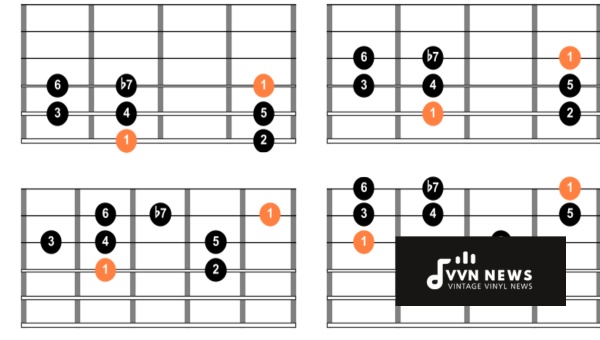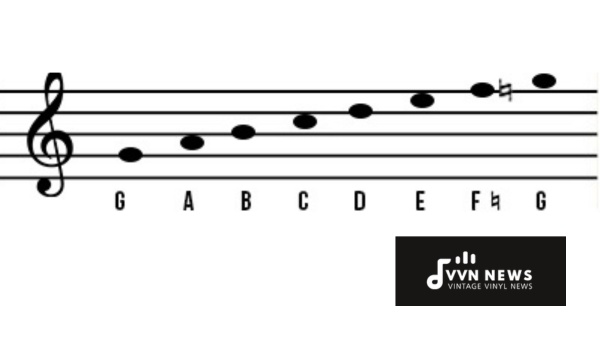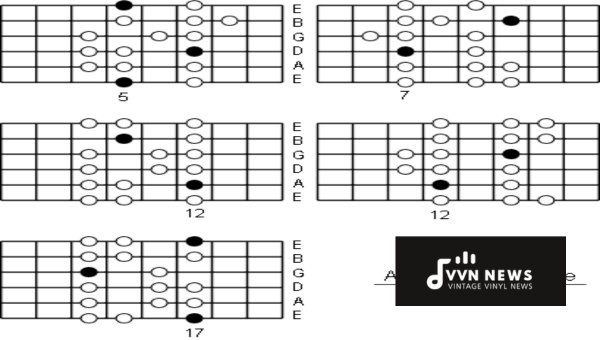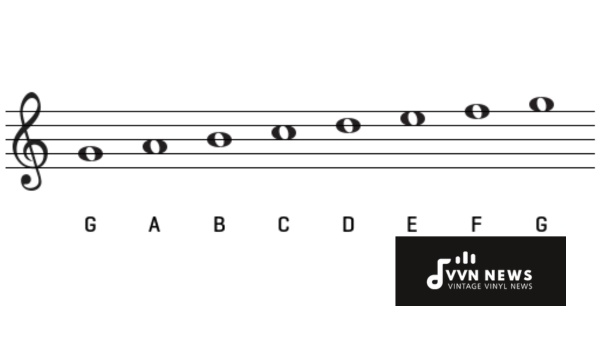In the world of music, patterns, and structures hold paramount importance.
They form the basis of every piece we listen to, be it rock, classic, blues, or jazz.
One unique structure that has intrigued musicians for generations is the Mixolydian mode.
With its unique blend of tones and semitones, it’s widely adored for its harmonic balance and distinctively smooth tone.
You might be surprised at how extensively the Mixolydian mode has been used without you even noticing it!
It’s in the catchy hooks of many pop songs, adding just a touch of exotic flair, or in famous rock riffs where it gives a tune its ‘edge’.
Whether you are a musician looking to learn more about scales or simply a curious listener with an ear for detail, Mixolydian mode can enrich your musical journey in unexpected ways.
What Are Musical Modes?
Musical modes are essentially different ways that the major scale can be rearranged.
Instead of simply playing your scale from the first note to the last and looping back, you start and end on a different step each time, creating a unique pattern.
These various configurations are what we refer to as musical modes.
There are seven unique musical modes, each with its flavor and personality.
They include Ionian (the major scale), Dorian, Phrygian, Lydian, Mixolydian, Aeolian (the natural minor scale), and Locrian.
The significance of these modes lies in their ability to bring distinct emotions, moods, and vibes into music.
For example, songs written in Lydian often sound mystical while pieces in Dorian have a jazzy feel.
By playing with modes, musicians have more tools at their disposal for creating fascinating melodic lines and compelling harmonic progressions.
The Impact of Musical Modes
Musical modes aren’t just theoretical constructs; they’re critical to making anything sound ‘musical’.
By contrasting these modal structures against one another or layering them together artistically, composers can craft compelling narratives through sound alone.
In short, by mastering musical modes, you’ve got all the ingredients needed for an auditory feast!
Above all else though – they highlight that music isn’t set in stone; it’s fluid and ever-changing with endless possibilities based upon a handful of notes rearranged by step sequence.
Also Read: Lydian Mode [Brighten Your Melodies With This Unique Scale]
What is the Mixolydian Mode?

The Mixolydian mode is one of the seven musical modes, taking its name from the ancient Greek city of Miletus.
It falls between Dorian and Aeolian modes in terms of interval patterns. This mode particularly stands out because it’s built on the fifth degree of the Diatonic scale.
To put it simply, if you take a major scale and lower the seventh note by a half-step or one fret on your guitar, what you’ll get is a Mixolydian scale.
That simple alteration lends a whole new character to this mix of notes, making it more versatile and intriguing.
The Mixolydian mode has often been used in various music genres over history due to its bluesy sound that is unique yet quite familiar to listeners’ ears.
The distinction this musical structure provides can bring a fresh perspective to your melodies, whether you are playing an instrument or crafting a composition.
How Does the Major Scale Transform into Mixolydian Mode?
The relationship between the Major Scale and the Mixolydian Mode is much more intertwined than one might think. It’s just about one simple adjustment.
Stepwise Guide to Derive Mixolydian from Major Scale
- If we take any Major Scale, it consists of seven unique tones. For instance, consider the G Major scale, which comprises ‘G – A – B – C – D – E – F# – G’.
- To transition this to a ‘Mixolydian mode’, an alteration in just one note is necessary. Specifically, we flatten (lower by a half step) the seventh note.
- Let’s execute this on our example scale (G Major). The seventh note of this scale is ‘F#’. When we flatten it, it converts from ‘F#’ to ‘F’. This leads us to a new pattern: ‘G – A – B – C – D – E – F – G’, which is recognized as the ‘G Mixolydian mode.’
The beauty of this transformation lies in subtlety and simplicity: A small shift creates a considerable effect on how we perceive the scale—adding a distinctive flavor that makes music interesting and captivating.
This newfound knowledge can pave your path toward exploring musical realms that you may never have ventured into before, bringing crisp freshness to your melodies.
The Mixolydian Mode Scale Degrees

In music theory, scale degrees are used to determine a note’s position in a scale or a mode.
Delving deep into the Mixolydian mode, you’ll see a structure quite characteristic of its own.
Let’s dissect the scale degrees of the Mixolydian mode:
- Root: The root, as per the norm with other scales and modes, serves as our starting point. It is the tonal center around which every other note orbits.
- Major Second: Moving up one whole step from the Root gets us to the Major Second. The relationship between these first two notes sets up an knowledge of tonality for the entire mode.
- Major Third: Next in line is the Major Third, another whole step from its predecessor. This is what gives our Mixolydian scale its major-sounding quality or feel.
- Perfect Fourth: A half-step up and we meet the Perfect Fourth. A universal note found in almost all scales and modes.
- Perfect Fifth: Continuing by another whole step takes us to Perfect Fifth, which further strengthens the major-ish vibe of our Mixolydian mode.
- Major Sixth: You make another advance of a whole step from there and bump into Major Sixth – another familiar face commonly found in various modal scales.
- Minor Seventh: Finally, another whole step leads us to Minor Seventh – The distinguishing factor of this mode that gives it an edgy sound unlike any standard major scale– there’s where lies our delightful twist!
By identifying these scale degrees within a piece of music, you’ll start hearing how they influence melody and harmony progression throughout any composition that uses this intriguing musical mode.
Also Read: Aeolian Mode [The Secret To Creating Moody & Expressive Music]
How Can One Play the Mixolydian Scale on Various Instruments?
The Mixolydian scale is versatile and it can be played on different types of instruments.
So, irrespective of whether you’re a guitarist, pianist, or flutist, the Mixolydian mode always adds a new dimension to your music.
Below, we will dive into how to play this fascinating scale on various instruments.
Guitar
The skill of playing scales omits the necessity to stick to traditional patterns. It is not as daunting as it may seem at first.
Here is how you can play the G Mixolydian scale (one of the most common forms) on a guitar:
- Start at the 3rd fret (G note) on the 6th string.
- Continue up with B flat on the same string.
- Move to the next string and play C, D, and E.
- Repeat similar patterns until reaching G again on another octave.
Remember that practice makes perfect!
Piano
The structure used for playing any musical scale remains identical regardless of which key you begin with.
Here’s a simple breakdown for playing the C Mixolydian scale:
- Start by pressing middle C(White Key).
- Follow this up with D and E(White Keys).
- Next comes F(White Key), then G(A white key).
- Going forward play flat A (A Black Key close to A White Key), Finishing off with another B flat.
Of course, it takes a while before one can get good at it!
Violin
For stringed instruments like violin still holds that practicing scales could be beneficial for doing flawlessly. For instance:
- Begin from the open G string.
- Continue with A and B notes on the same string.
- Transitioning to D string hit open D and then F natural followed by G note.
- Finish off by shifting to another octave if desired.
One important reminder, the goal isn’t just to learn to play scales, but to get acclimated with your instrument.
The more you experiment with modes like Mixolydian, the more confident you’ll become in your playing.
The beautiful part about mastering this distinct scale is its universality.
Be it a guitar or a keyboard or some intricate stringed instrument like a violin or cello, the underlying concept and fundamental notes of Mixolydian remain the same – it’s all about harmony and infusing a unique vibrancy into any piece of music.
Also Read: The Locrian Mode [Unlock The Secrets Of This Unique Scale]
Which Famous Songs Utilize the Mixolydian Mode?

The Mixolydian mode is a popular choice for many legendary songwriters.
Let’s delve into five well-known songs that make prominent use of this particular musical mode.
1. “Sweet Child O’ Mine” by Guns N’ Roses
In “Sweet Child O’ Mine,” you’ll find the Mixolydian mode in the intro’s distinctive riff.
The legendary guitarist, Slash, plays an elongated version of the D Mixolydian scale during this section.
This allows him to create a powerful harmony that significantly contributes to this classic rock anthem’s enduring appeal. Listen closely next time and appreciate it through fresh ears.
2. “Norwegian Wood” by The Beatles
This melancholic folk song composed by John Lennon and Paul McCartney employs E Mixolydian in its melody.
The sitar performance made famous by George Harrison also utilizes this mode and underscores this composition’s inherent tension, bringing about an immersive experience for listeners.
3. “L.A Woman” by The Doors
Meanwhile, in “L.A Woman”, The Door’s Robby Krieger delivers a bold E Mixolydian lead guitar part, enhancing the opening sounds and throughout the song’s verses.
Its pulsating rhythms keep the listeners on their toes, demonstrating just how versatile the Mixolydian mode can be.
4. “Clocks” by Coldplay
In Coldplay’s hit song, ‘Clocks’, Chris Martin composes using an E-flat Mixolydian scale for the piano arpeggios that introduce the track and continue throughout.
This weaving piece proves again how exploration of modes can texture even modern pop music
5.”Sweet Home Alabama” by Lynyrd Skynyrd
Finally, the Southern rock anthem ‘Sweet Home Alabama,’ relies on D Mixolydian for its familiar guitar riff—adding another layer to its spirited tempo.
The pull-off from the flattened seventh to the sixth note is the Mixolydian flavor that drives this worldwide hit.
These are just a few of the myriad of songs that draw upon the Mixolydian mode, expressing creative liberty and a simple yet impactful musical nuance.
It reveals how even through ages, musicians have used modes like Mixolydian as part of their toolset to compose enthralling pieces – timeless in their beauty and innovation.
Also Read: Musical Modes Explained [What Are They & How Do I Use Them?]
What Are Some Common Chord Progressions Compatible with the Mixolydian Scale?
One of the essential characteristics of the Mixolydian mode is its dominant seventh chord.
Due to this special feature, certain chord progressions align perfectly with the Mixolydian mode.
Chord I-IV
The first chord progression to consider is the I-IV progression. In a G Mixolydian scale, for example, this would translate to G-C.
This simple sequence of chords falls naturally within the Mixolydian and provides countless possibilities.
Chord I-bVII
The second classic Mixolydian chord progression is I-bVII. With a G Mixolydian, your chords will be G and F (a step down from dominant).
This is commonly seen in rock songs where tension and release hold sway.
Chord VII- IV-I
Another triad worth mentioning is the VII- IV-I chord progression, which gives a smooth flow when played in the context of Mixolydian mode.
Sometimes, to highlight that distinctive ‘b7’ sound of Mixolydian, musicians might also opt for a repetitive ‘I-bVII-I’ pattern making it pure mix-magic!
Moreover, there are also possibilities of introducing borrowed chords or oddly satisfying progressions using secondary dominants or tritone substitutions.
It’s essential though to remember that these sets are not rules but rather guidelines you can use when composing or improvising your piece in Mixolydian mode.
Most importantly, listen carefully and tune in to what sounds best to your ears. Add your flavor, express your emotions, and let the music guide you.
Also Read: Exploring The Classical Music Period [Impact On Modern Music]
FAQs About The Mixolydian mode
What exactly is the Mixolydian mode?
The Mixolydian mode is a musical scale, identical to the major scale, but with a flattened seventh note.
Why is the Mixolydian mode popular in rock music?
It’s popular due to its unique blend of major and minor tones, creating a ‘bluesy’ feel that’s perfect for rock music.
Can I use the Mixolydian mode in piano playing?
Absolutely! You can use the Mixolydian mode on any instrument, including the piano.
How does changing to a flattened seventh affect the music’s sound?
This subtle shift alters the tension within the music, often resulting in a brighter or happier feel overall.
Does Mixolydian offer unique chord progression possibilities?
Yes, it does. The flattened seventh of the Mixolydian opens up distinctive chord progressions that can be used creatively.
Conclusion
In essence, the Mixolydian mode unlocks a world of possibilities for musicians and listeners alike, encouraging the exploration of tonal nuances.
Whether you are strumming a guitar, playing piano keys, or composing on your DAW, understanding this musical mode can add a distinctive flavor to your sound palette.
Finally, let it be known that the depth of music is boundless; there’s always room for discovery and growth.
As Leonardo da Vinci rightly quoted, “Learning never exhausts the mind”. So keep your minds open to learning new musical concepts, modes like Mixolydian are just the beginning!








